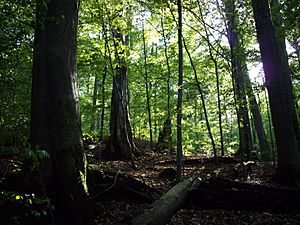Temperate deciduous forest facts for kids
Temperate deciduous forests are special places filled with trees that lose their leaves every year. These forests are found in areas that have warm, wet summers and cool winters. You can find them in many parts of the world, mostly in the Northern Hemisphere. This includes places like North America, East Asia, and much of Europe. In the Southern Hemisphere, you'll find them in Patagonia, which is in Chile and Argentina.
Some common trees in these forests in the Northern Hemisphere are oak, maple, beech, and elm. In the Southern Hemisphere, a tree called Nothofagus is very common. These forests also get a lot of rain throughout the year.
Contents
What Makes These Forests Special?
Temperate deciduous forests are known for their four distinct seasons. The trees change colors in autumn, lose their leaves in winter, and grow new ones in spring. This cycle helps the forest stay healthy and provides homes for many animals.
Where Do They Grow?
These forests need specific weather conditions to thrive. They need enough rain and a good mix of warm and cold temperatures. This is why they are found in certain parts of the world.
- North America: Large areas in the eastern United States and Canada.
- Europe: Many parts of Central and Western Europe, like France, Germany, and parts of Scandinavia.
- Asia: Areas in China, Japan, and Korea.
- South America: The southern tip of Chile and Argentina.
Common Trees and Plants
The types of trees you see depend on where the forest is.
- Northern Hemisphere: You'll often find tall oak trees, colorful maple trees, smooth-barked beech trees, and elm trees.
- Southern Hemisphere: Trees from the Nothofagus family are common.
Many other plants also grow here, like ferns, wildflowers, and shrubs. They all work together to create a rich environment.
How Humans Use and Affect Forests
People have lived near temperate deciduous forests for a long time. These forests have provided many useful things.
Using Forest Resources
Historically, people used wood from these forests for many purposes.
- Timber: Wood was cut down to build houses, furniture, and other structures.
- Charcoal: Wood was also burned to make charcoal, which was used for heating and cooking.
When Europeans first came to North America, they even made a substance called potash from tree ashes. This potash was sent back to Europe to help plants grow better.
Challenges for Forests
Over time, many of these forests have changed a lot.
- Less Forest Land: Today, less than a quarter of the original forests remain. Many have been cleared for farms and towns.
- Forest Fragments: What's left are often small pieces of forest surrounded by roads and fields. These small "islands" can be different from the large, original forests.
- Diseases: New diseases can harm trees. For example, diseases have caused many chestnut and elm trees to disappear.
Animals and Their Impact
Some animals, like deer, have become very common in these changed forests.
- Deer Populations: Large numbers of deer can eat too many young trees and plants. This makes it hard for new trees to grow.
- Plant Life: Deer also eat many types of flowering plants, which can change the forest floor.
- Missing Predators: Because large predators like wolves are often gone, deer populations can grow very big. This means deer will likely continue to have a big impact on the forests.
Gallery
See also
 In Spanish: Bosque templado caducifolio para niños
In Spanish: Bosque templado caducifolio para niños
- Temperate coniferous forest
- Temperate broadleaf and mixed forest
- International Year of Forests
- Old-growth forest
- Tropical evergreen forest
- Tropical deciduous forest






